Stainless Steel Ball Bearings
Table of Contents
Categories
-
Adapter Sleeves (9)
-
Ball Bearings (1)
-
Ball Screw Bearings (2)
-
Ceramic Bearings (23)
-
Pillow Block Bearings (4)
-
Plain Bearings (30)
-
Roller Bearings (12)
-
Slewing Bearings (43)
-
Sliding Block (3)
-
Stainless Steel Bearings (27)
-
Super Precision Bearings (6)
-
Thin Section Bearings (9)
-
Track Rollers (4)
-
Universal Joints (1)
Definition of Stainless Steel Ball Bearings
Stainless steel ball bearings are ball bearings made of stainless steel. Their characteristics include strong corrosion resistance, high temperature resistance, and excellent corrosion resistance. They are often used in applications that have harsh environmental requirements or require anti-rust properties, such as food processing, medical equipment, and Chemical industry.

FHD Bearings is an ISO 9001:2015 certified manufacturing enterprise .Our company has a wide range of products in stock covering a wide range of areas to ensure that we are able to meet the diverse needs of our customers. We offer a wide selection of both models and specifications to ensure that our customers are able to quickly obtain the products they need and meet their specific engineering and business requirements.
Materials of Stainless Steel Ball Bearings
Has excellent corrosion resistance and hardness and is often used in demanding industrial applications.
A general stainless steel material, used in some low-demand environments and has good corrosion resistance.
Contains molybdenum, which improves resistance to corrosion and acidic environments. It is often used in harsh conditions such as marine environments.

AISI 420 stainless steel
It has high hardness and magnetic properties, and is suitable for some special industrial applications with higher requirements.
Features of Stainless Steel Ball Bearings

1.Corrosion resistance: Stainless steel material has good corrosion resistance and is suitable for humid, acid and alkali environments, and occasions that require high rust resistance.
2.High temperature resistance: Stainless steel ball bearings can usually work at higher temperatures, have certain heat resistance, and are suitable for applications in high temperature environments.
3.Non-magnetic: Some stainless steel materials are non-magnetic and are suitable for applications that are sensitive to magnetic interference, such as medical equipment or specific scientific research instruments.
4.Hygiene: Stainless steel ball bearings comply with hygiene standards and are suitable for areas with high hygiene requirements such as food processing and medical equipment.
5.Lightweight: Stainless steel is lighter than traditional steel, which helps to reduce the overall weight of the bearing and reduce the load on the equipment.
6.High strength: Stainless steel materials usually have high strength and can meet some high-load, high-strength industrial applications.
7.Not prone to rust: Stainless steel has good rust resistance in humid and corrosive environments, helping to extend the service life of bearings.
Advantages of Stainless Steel Ball Bearings
1.Low friction coefficient: The surface of stainless steel material is smooth and the friction coefficient is relatively low, which helps to reduce friction loss and improve efficiency.
2.Low noise: Stainless steel ball bearings produce relatively low noise during operation and are suitable for occasions with high noise control requirements.
3.Strong corrosion resistance: Not only resistant to rust, but also has good corrosion resistance to a variety of chemical substances, suitable for special industrial environments.
4.Easy to clean: The surface is smooth, not easy to accumulate dust, easy to clean, and relatively simple to maintain.
5.Can run without lubrication: Some stainless steel ball bearings can run without lubrication in some application scenarios, reducing lubrication maintenance costs.
6.Environmental protection: Stainless steel is a recyclable and environmentally friendly material that meets the requirements of sustainable development.
7.Adapt to diverse environments: Stainless steel ball bearings have strong adaptability and can operate stably in diverse industrial environments.

Applications of Stainless Steel Ball Bearings

- Food processing industry: Used in food machinery and equipment, such as food conveyor belts, food packaging machines, etc., because of its hygienic and anti-corrosion properties.
- Medical equipment: Suitable for medical equipment, such as medical scanning equipment, operating tables, dental equipment, etc., which have strict hygiene and cleanliness requirements.
- Chemical Industry: Used in chemical processing equipment such as chemical reactors, mixing stirrers, etc. due to its corrosion resistance.
- Marine engineering: Suitable for marine equipment, such as ocean detection instruments, diving equipment, etc., due to its ability to resist seawater corrosion.
- Aerospace: Used in aerospace equipment, such as aircraft engine parts, spacecraft bearings, etc., because of its light weight and high strength.
- Electronic equipment: Used in precision instruments, such as optical instruments, semiconductor equipment, etc., due to their non-magnetic and hygienic properties.
- Special environment: Suitable for equipment in high temperature, high humidity, acid and alkali environments, such as high temperature stoves, equipment in humid environments, etc.
- Textile Machinery: Used in textile equipment such as spinning machines, looms, etc. due to its corrosion and chemical resistance.
- Special-purpose vehicles: Suitable for special-purpose vehicles such as food transport trucks and medical ambulances.
Key Manufacturing Process of Stainless Steel Ball Bearings
Selection of raw materials:
Select stainless steel materials suitable for making stainless steel bearings. Common ones include AISI 440C, AISI 304, AISI 316, etc.
Material pretreatment:
Pretreatment of raw materials, including cutting, forging, heat treatment and other steps, to form a shape and performance that meets the requirements of the bearing.
Cold drawing or hot rolling:
The pre-treated material is cold drawn or hot rolled to obtain the desired shape and size.
Sphere forming:
Stainless steel materials are made into spheres in bearings through processes such as cold forging, hot forging or injection molding.
Outer ring and inner ring forming:
The material is formed into the outer ring and inner ring of the bearing through cold drawing or cold heading processes.
Ball, outer ring, and inner ring finishing:
The ball, outer ring, and inner ring are finely processed to ensure that their size, shape, and surface quality meet the requirements.
Assembly:
Assemble the ball, outer ring, inner ring and other components, usually including bearing seats, sealing rings and other components.
Lubrication:
After assembly is completed, lubricate the bearing according to the usage requirements to ensure its normal operation.
Inspection:
Strict quality inspection is carried out on the manufactured bearings, including dimensional inspection, axial clearance inspection, rotation accuracy inspection, etc.
Packaging:
After inspection, the bearings are packaged to prevent damage during transportation and storage.

FAQ - Frequently Asked Questions

Stainless steel ball bearings are made of stainless steel, which have the characteristics of corrosion resistance and high temperature resistance, and are suitable for special environments; while ordinary steel ball bearings usually use carbon steel.
Stainless steel ball bearings are suitable for high temperature, humidity, acid and alkali environments, and are often used in food processing, medical equipment, chemical industry, etc.
Stainless steel ball bearings have excellent corrosion resistance and good resistance to chemical media such as water, acid, and alkali.
Stainless steel ball bearings are suitable for higher temperature environments and can generally operate stably in high temperature ranges. The specific temperature range depends on different stainless steel materials.
Stainless steel ball bearings are suitable for marine equipment, such as ocean detection instruments and diving equipment, because of their ability to resist seawater corrosion.
Some stainless steel materials are non-magnetic and are suitable for applications sensitive to magnetic interference, such as medical equipment and scientific research instruments.
Stainless steel ball bearings can be lubricated with grease or oil. Choose the appropriate lubrication method according to different application scenarios and requirements.
The maintenance of stainless steel ball bearings includes regular lubrication, keeping clean, dust-proof, anti-corrosion, etc. to ensure their long-term stable operation.
Some stainless steel ball bearings can operate without lubrication in some application scenarios, reducing lubrication and maintenance costs.
Compared with other special bearings, stainless steel ball bearings have the characteristics of corrosion resistance, high temperature resistance, and hygiene, and are suitable for a wider range of industrial applications.
Installation and Maintenance of Sliding Block Bearings
Installation
- Preparation: Ensure that the work area is clean and check the condition of the bearings and shafts to ensure that there is no damage or contamination.
- Lubrication Selection: Select the proper lubricant and make sure grease or oil lubrication is appropriate for the work environment and load requirements.
- Bearing Preheating: If necessary, preheat the bearings using hot air or an oven to allow for easier mounting on the shaft.
- Correct Mounting: Use proper tools and techniques to mount the bearing on the shaft to ensure a good fit between the bearing and the shaft.
- Alignment Check: Ensure that the bearing is aligned after mounting to avoid additional loading due to improper alignment.
- Seal Mounting: If seals are present, ensure proper mounting to prevent dust and contaminants from entering the bearing.


Maintenance
- Regular Lubrication: Regularly check and replace the lubricant according to the manufacturer’s recommendations to ensure that the bearings always operate in a well-lubricated condition.
- Keep Clean: Clean the area around the bearings regularly to prevent the ingress of dust and impurities and to reduce friction and wear.
- Dust Protection: If applicable, install additional dust shields or seals to increase the protection of the bearings.
- Monitor Temperatures: Regularly monitor bearing temperatures. Abnormal warming may be a warning sign of bearing failure, so take action.
- Periodic Inspection: Conduct periodic inspections, including checking bearing clearance, axial clearance and bearing appearance, to detect potential problems in a timely manner.
- Trouble Shooting: If there is abnormal noise, vibration or temperature increase, timely troubleshooting and take appropriate repair or replacement measures.
Related Posts
Exploring Stainless Steel Bearings: Expert Insights
Table of Contents Categories .elementor-heading-title{padding:0;margin:0;line-height:1}.elementor-widget-heading .elementor-heading-title[class*=elementor-size-]>a{color:inherit;font-size:inherit;line-height:inherit}.elementor-widget-heading .elementor-heading-title.elementor-size-small{font-size:15px}.elementor-widget-heading .elementor-heading-title.elementor-size-medium{font-size:19px}.elementor-widget-heading .elementor-heading-title.elementor-size-large{font-size:29px}.elementor-widget-heading .elementor-heading-title.elementor-size-xl{font-size:39px}.elementor-widget-heading...
Read MoreSteel Industry: How Bearings Play A Key Role
Table of Contents Categories Steel Industry: How Bearings Play A...
Read MoreThe Critical Role Of Food-grade Flange Bearings In Food Equipment
Categories The Critical Role Of Food-grade Flange Bearings In Food...
Read MoreAdvantages And Maintenance Of Stainless Steel Balls
Categories Advantages And Maintenance Of Stainless Steel Balls Table of...
Read MoreStainless Steel Bearings: Powering Precision in Machinery
Categories Stainless Steel Bearings: Powering Precision in Machinery Table of...
Read MoreBearings Built to Last: The Stainless Steel Revolution in Engineering
Explore the Stainless Steel Revolution in engineering - where durability,...
Read More

















